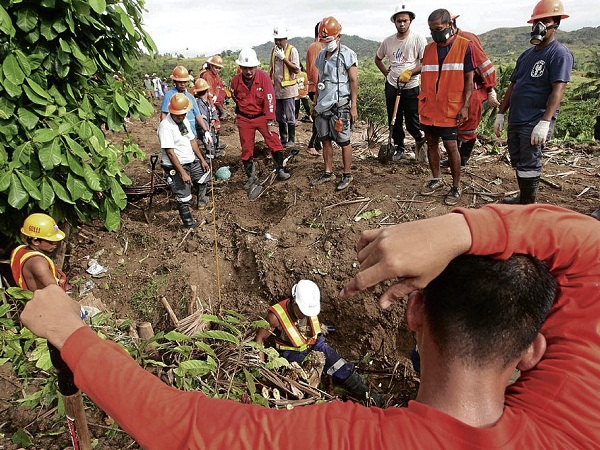Quake haunts Negros villagers anew

THIS PICTURE, taken in February 2012, shows rescue workers digging in search of survivors in Barangay Planas, Guihulngan City, Negros Oriental, after a 6.9-magnitude earthquake. TONEE DESPOJO/CDN
When the ground shook in the evening of Aug. 31, residents of Barangay Solonggon in La Libertad town in Negros Oriental province went out of their makeshift homes and braced for the worst.
“The people grabbed some of their belongings and went out. Fortunately, it was not that strong,” Barangay Chair Rene Gargoles said.
The 7.6-magnitude earthquake that hit Eastern Samar and parts of the Visayas and Mindanao was nearly 500 kilometers from Solonggon, but the villagers could not have felt it closer.
At least 129 families or more than 500 people are still living in tents and makeshift houses on the grounds of the barangay hall in Solonggon, nearly seven months after a 6.9-magnitude earthquake struck Central Visayas on Feb. 6, devastating northern towns and one city of Negros Oriental.
The earthquake, the worst tragedy to hit the province in recent years, killed 41 people and destroyed or damaged 440 houses, 22 bridges, nine church buildings, nine establishments, school buildings and roads.
Article continues after this advertisementThousands of people were left homeless while many more were moved, refusing to go back to their homes weeks after the earthquake out of fear that the temblor might strike again.
Article continues after this advertisementWorst-hit
Solonggon was among the worst-hit villages in the province. A landslide wiped out parts of the village, burying people alive. At least 38 remain missing and are presumed dead.
Eighteen people were also missing in Barangay Planas in Guihulngan City.
When the Aug. 31 tremor struck the Visayas, fear gripped a number of residents who immediately went out of their houses.
Fr. Felipe Luis Ferolina, La Libertad parish priest, said he, too, went out of the convent at the town proper. “I saw other people who went out of their houses. They are still afraid,” he said.
Ferolina said the situation had not yet returned to normal. Some residents are still traumatized; a few have suffered from nervous breakdown or became mentally disturbed.
“Hundreds [of people] still do not have permanent homes and they need livelihood support,” he said.
Relocation site
The municipal government has identified a 4.3-hectare relocation site for the evacuees in Solonggon. The place would be ready for relocation in November or December, Gargoles said.
Some of the construction materials, including those for roofing, were provided by the municipality. Private companies have also offered to help.
While students have long returned to school, many of them still attend classes in makeshift classrooms because the damaged school buildings have not yet been fully reconstructed and repaired.
Pupils of Ayungon Central Elementary School in Ayungon town go to classes in two large tents, said Salustiano Jimenez, provincial schools superintendent. Roughly 100 classrooms in public elementary and high schools are needed to replace those destroyed by the earthquake, he said.
The Department of Education expects the construction of new classrooms to be completed within the year. Private companies have also donated classrooms in some areas.
Bridges rehab
The rehabilitation of bridges, however, will take longer. Twenty-two bridges were destroyed or damaged during the earthquake and 10 needed to be replaced.
Only six replacement bridges have been included in next year’s program of projects of the Department of Public Works and Highways, according to engineer Ramie Doroy of the province’s first engineering district.
Almost all of the damaged bridges are passable, with one having a detour.
Even as the residents of the earthquake-hit areas continue to struggle to fully recover, they have looked beyond their own plight.
On Sunday, churchgoers responded to the call of the Diocese of San Carlos City to help the victims in Eastern Samar. Ferolina said the parish collected more than P1,000 for a second collection of contributions during the Mass.
“It’s a thanksgiving donation because others also helped us when we needed it,” he said.